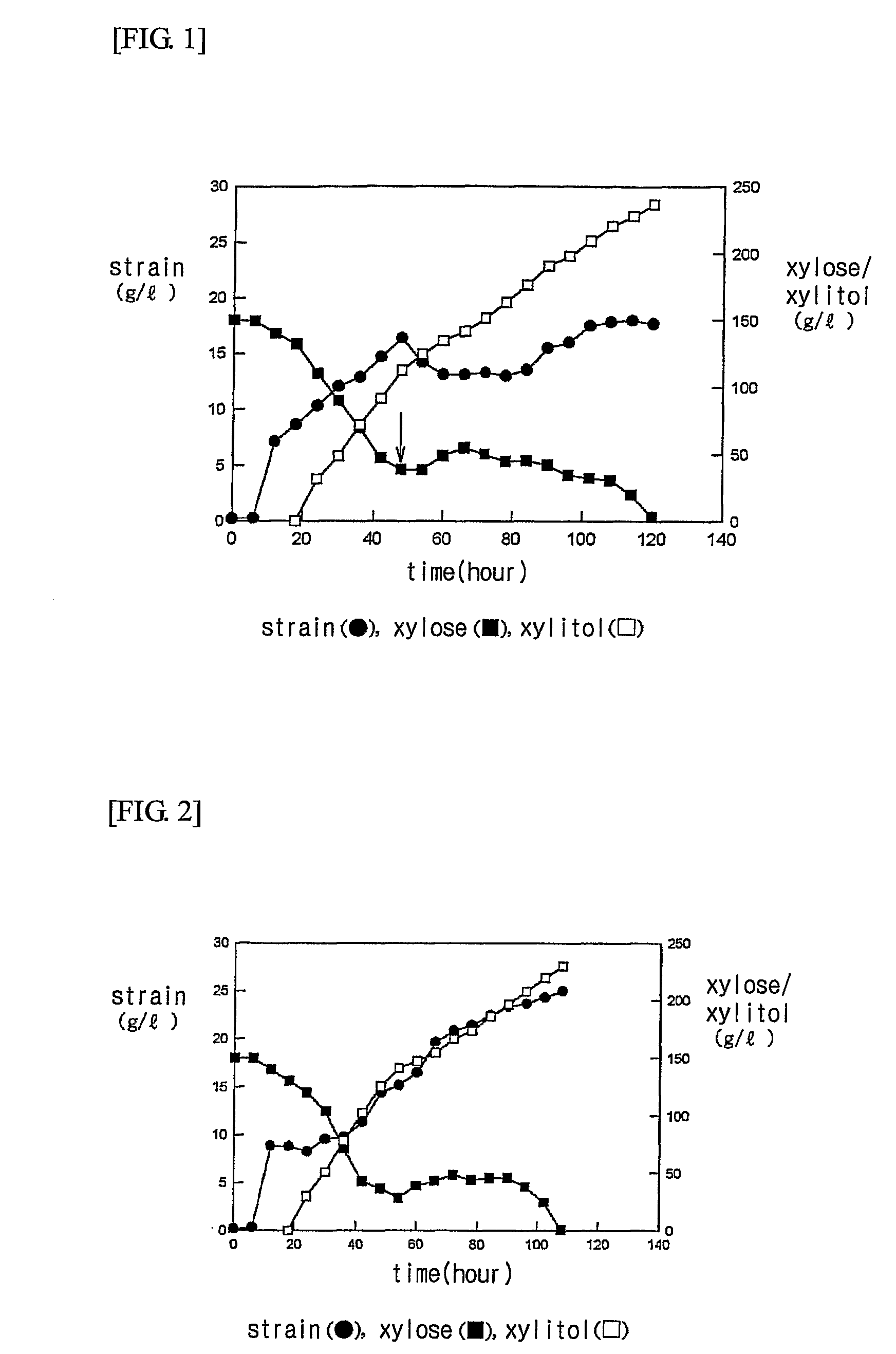Method for preparing xylitol with high yield using recycling microorganism
a technology of microorganisms and xylitol, which is applied in the field of preparing xylitol with high yield using recycling microorganisms, can solve the problems of high yield of xylose or xylitol, risk of high-temperature and high-pressure reaction and waste disposal, and achieve high yield
- Summary
- Abstract
- Description
- Claims
- Application Information
AI Technical Summary
Benefits of technology
Problems solved by technology
Method used
Image
Examples
example 1
Chemical Medium
[0033]Seed culture: the published Candida tropicalis KCTC 7221 cells were inoculated onto 50 ml of a growth medium contained in a 250 ml flask and cultured at 240 rpm and 30° C. for 10 hours.
[0034]Main culture: the seed culture was introduced and cultured in a 7 l fermenter (Biotron Ltd.) containing 2 l of a chemical medium composed of 150 g / l of xylose, 5 g / l of urea, 5 g / l of potassium diphosphate, 0.2 g / l of magnesium sulfate, metal salts (7 mg / l of MnSO4.4H2O, 4 mg / l of CoCl2.6H2O, 2 mg / l of NaMoO4.2H2O, 2 mg / l of ZnSO4.7H2O, 1 mg / l of AlCl3.6H2O, 2 mg / l of CuCl2.2H2O, 0.5 mg / l of H3BO3, 40 mg / l of FeSO4.7H2O), and vitamins (5 mg / l of ascorbic acid, 10 mg / l of biotin, 25 mg / l of choline, 50 mg / l of folic acid, 10 mg / l of inositol, 25 mg / l of nicotinic acid, 1 mg / l of p-aminobenzoic acid, 5 mg / l of pantothenic acid, 1 mg / l of pyridoxine, 100 mg / l of riboflavin, 25 mg / l of thiamine). Fed-batch culture was performed in such a manner that during the fermentation, the ...
example 2
Cell Recycling Culture by Centrifugation
[0037]After culturing was performed in the same chemical medium as in Example 1 until immediately before xylose was depleted, the culture was centrifuged at 5,000 rpm for 20 minutes. The collected cells were inoculated onto 2 l of a fresh chemical medium and re-cultured. At this time, culture conditions were the same as in Example 1 and the concentrations of xylose and xylitol were measured in the same manner as in the above Experimental Example.
[0038]2 l of the primary culture before the centrifugation contained 218 g of xylitol. At this time, xylitol productivity was 2.3 g / l-h and the yield of xylitol to xylose was 74%. As a result of 14 recycling culture by the centrifugation, 3,076 g of xylitol was obtained from 28 l of whole culture and xylitol productivity and yield were respectively 5.4 g / l-h and 82% (see FIG. 3).
[0039]The production amount, productivity, and yield of xylitol after the 14 recycling culture by the centrifugation were res...
example 3
Cell Recycling Culture by Vacuum Microfiltration (Chemical Medium)
[0041]After culturing was performed in a bioreactor containing the same chemical medium as in Example 1 until immediately before xylose was depleted, the culture was transferred to a vacuum microfiltration system attached to the bioreactor to separate spent cells and a culture filtrate. The spent cells were recycled to the bioreactor containing 2 l of a fresh chemical medium and re-cultured. Culture conditions were the same as in Example 1 (see FIG. 4).
[0042]At this time, the vacuum microfiltration system was provided with hollow fiber membranes (0.45 μm in porosity, Mitsubishi Rayon, Japan) made of polyethylene. The hollow fiber membranes were attached to silicon tubes of both sides of the vacuum microfiltration system. Through the hollow fiber membranes, microfiltration was performed in a vacuum created by a pump. The concentration of xylitol was measured in the same manner as in the above Experimental Example.
[0043...
PUM
| Property | Measurement | Unit |
|---|---|---|
| boiling point | aaaaa | aaaaa |
| concentration | aaaaa | aaaaa |
| density | aaaaa | aaaaa |
Abstract
Description
Claims
Application Information
 Login to View More
Login to View More - R&D
- Intellectual Property
- Life Sciences
- Materials
- Tech Scout
- Unparalleled Data Quality
- Higher Quality Content
- 60% Fewer Hallucinations
Browse by: Latest US Patents, China's latest patents, Technical Efficacy Thesaurus, Application Domain, Technology Topic, Popular Technical Reports.
© 2025 PatSnap. All rights reserved.Legal|Privacy policy|Modern Slavery Act Transparency Statement|Sitemap|About US| Contact US: help@patsnap.com



